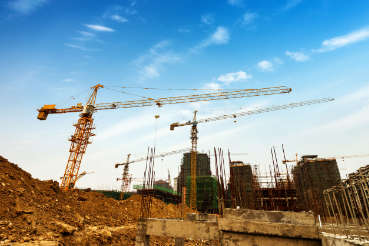In tunnelling, at construction sites and for groundwater remediation, huge amounts of effluents have to be purified. For this purpose, we offer a compact and space-saving option, with the lamella clarifier, to treat the water on site.
Tunneling
During a tunnel construction, it can be expected that layers, carrying groundwater, are bored into or through. In this case, large amounts of water, usually soiled with drilling dust/dirt, have to be purified, as it is impossible to pump the water into the receiving water. Furthermore can be expected that in case of a mechanical breakdown, hydraulic oil may mix with the water. Using a lamella separator, the water can be treated and pumped into the receiving water. With a lamella separator, not only particles can be separated, but also oils concentrated, which can be skimmed off the water surface. During the tunnel heading, walls are concreted at the same time. The concrete is produced outside the tunnel and pumped to the section, where it is processed via long pipelines. The pipelines have to be flushed if interferences occur during the tunnel driving. The concrete is flushed out with water, individual fractions separated and cementitious water remains. The cement particles can be separated using a lamella separator. The individual fractions can be reused at a later time. Therefore, not only raw materials are saved and production plants protected (manufacturing optimisation, reduced effort for cleaning and maintenance), but also emissions to the environment are reduced.
Ground water remediation
During a ground water remediation the groundwater, containing toxic substances, is pumped out and purified by a precipitation / flocculation step. Thereby the dissolved substances precipitate, are present as particles and can be separated with a lamella separator.
Washing of soil
Especially on old industrial sites, hydrocarbons, tars and other toxicities are present in the soil. These contaminated soils are treated in a compley way and large amounts of washing water are needed. For this purpose, we offer appropriate solutions for the treatment and recirculation of the washing water.

Our products are available to rent for pilot tests. Due to our extensive rental park, we can put together complete test systems individually for your task.
The AlpTransit Gotthard is a future oriented flat track through the Alps. The Gotthard base (with a length of 57km the longest tunnel worldwide) is the heart of the new rail link. The pioneer achievement of the 21st century will lead to a significant improvement of the travel and transport service in Europe. Together with the ARGE partners Arnold AG and Aggregat AG (Flüelen) the AWATEC AG was awarded the contract for the lot 106 (effluent treatment Erstfeld). The contract basically covers the construction and operation of a effluent treatment plant with a rate of 50-150 l/s. Leiblein lamella separators are integrated into this treatment plant.
The unsoiled mountain water from the surrounding rocks and the process water needed for the tunnel construction is collected in an infiltration ditch and fed into the treatment plant. The water is pre-treated in a flow-dividing structure, which primary regulates and distributes the water streams but also separates gravel, sand and coarse material.
After adding flocculant, the effluent is fed into lamella separators, which fulfill two functions at the same time. Free and finely divided, dispersed oils accumulate (following the coalesce principle) at the lamella packs and rise in form of drops to the water surface, where they get sucked off. The introduced turbidity material, which through clogging, that means the filling of the water bed and a shifting of the light and temperature climate of the surface water, harms the ecosystem, is coagulated by the flocculant. The coagulated materials settle onto the lamellas and slide down to the bottom. The resulting sludge is exported, dewatered and stored for further treatment.
The water with an increased pH value, due to the concrete processing, is neutralised by adding carbon dioxide. This process offers advantages regarding environmental pollution and operational safety when compared with neutralisation using mineral acids: hyperacidity or increased salinity (eutrophication) of the effluent is impossible and a considerably easier handling is given compared to toxic and corrosive mineral acids. Precipitating chalk, resulting from the neutralisation, is sedimented in a basin.
The starter tunnels bored by the tunnel boring machines and the cross passages between the main tunnels are driven by drilling and blasting. Blasting agent residues and precipitation of the blasting process lead to an enrichment of nitrogen compounds, especially nitrite and ammonium, of the tunnel water. The water is treated by adding sodium hypochlorite and filtering through active carbon. Absorbable organic halogenated compounds (AOX) are bound by the active carbon when exceeding permitted tolerances and thus get filtered out.
To ensure sufficient reserve capacity, the system is extended automatically when exceeding a wastewater rate of 50 l/m, so that a steady throughput of 150 l/m can be achieved. Large water ingresses can be caught and stored in two reservoirs with a volume of 1000 m³. Even if the volume of the reservoir proofs to be insufficient, environmental hazards are practically impossible due to an emergency procedure of flocculation and neutralization using sulphuric acid.